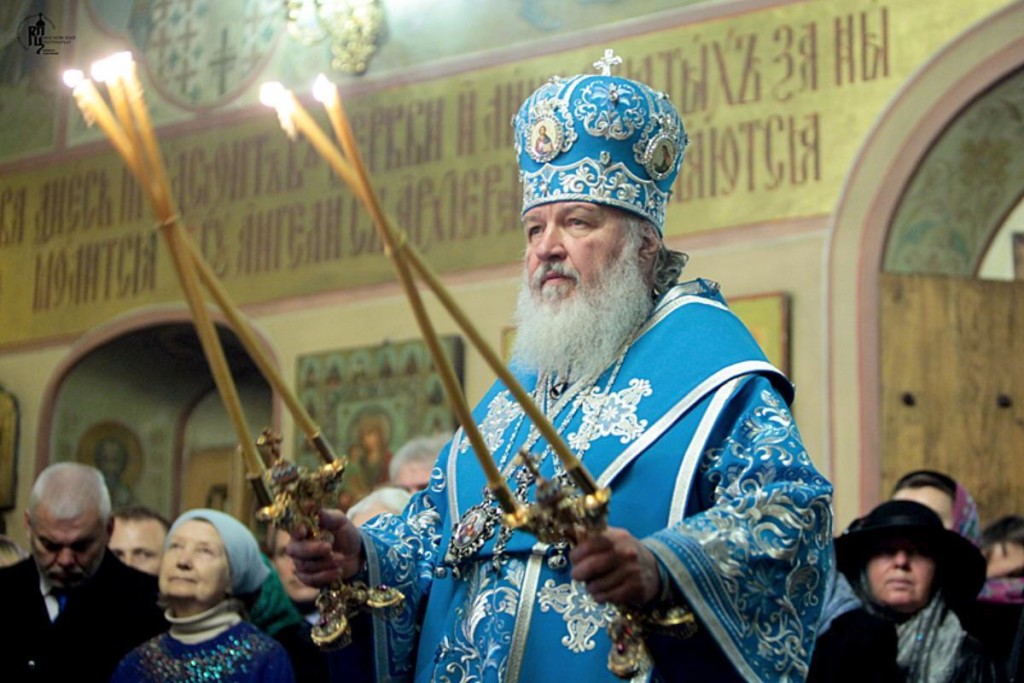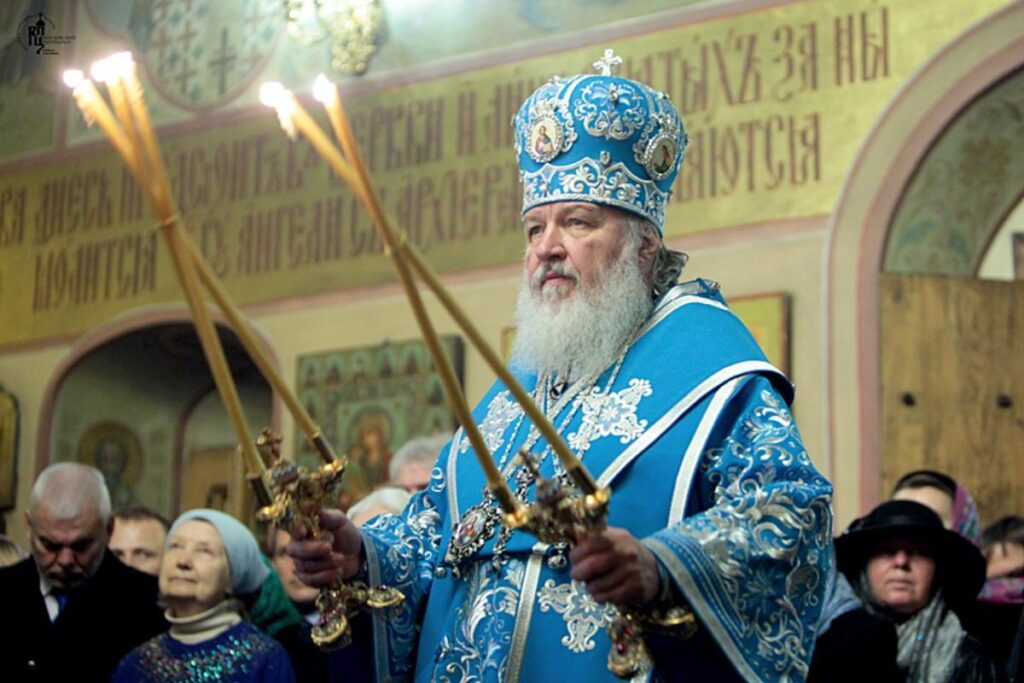
In their song “Punk Prayer”, anti-Putin feminist group Pussy Riot criticizes the use of Russian Orthodox to deify the political regime:
Bless our festering bastard boss,
Let black cars parade the Cross,
The Missionary’s in class for cash,
Meet him there, and pay his stash.
Members of the group famously received two years jail time after illegally performing the song in a Moscow Cathedral in 2012. Though the protest itself was radical, the argument calling the Russian Orthodox Church a politicized shell of its former self is a common thread among Russian opposition and Western commentators. It’s an easy one to make when the Moscow Patriarch – head of Russian Orthodox – Kirill I lauds Putin’s leadership as “a God’s miracle”, decries the West as a doomed, materialist civilization and goes on television to urge Russian citizens not to worry about falling oil prices or the devalued ruble. All this from an institution that has received billions of dollars’ worth of restituted property from the government after it was appropriated by the Bolsheviks, and oversees a business empire complete with Orthodox banks, shopping malls and bottled holy water.
In Pussy Riot’s latest video for their song “Chaika”, or “seagull”, the group calls out the church’s irreligious corruption and affluence. (PussyRiotVideo/Youtube)
Beyond the obvious hypocrisies, the church’s enthusiastic championing of the ultra-conservative and anti-Western elements of Putin’s brand can seem contradictory given the USSR’s categorical decimation of Russian Orthodox during the Cold War—priests were executed and replaced with KGB informants, churches were converted to atheistic propaganda centers and what was left of the community of believers became a spiritual spearhead of anti-Soviet protest. But historically, Russian Orthodox has always been exploited for political marketing. Both the Crimean War of 1853 and the Russo-Turkish War of 1877 saw the Tsar paint Russian expansionism into the Ottoman Empire as “a noble defense” of oppressed Serbs and other Orthodox Christian minorities living in the majority Muslim state. Nicolas I and Alexander II were not moral crusaders. They knew a religious narrative would fuel the necessary Islamophobic, anti-Turkish sentiment to motivate a strategic war. For those with a cyclical philosophy of history, Putin’s talk of a “holy war” against ISIS to defend persecuted Christians in Syria and Iraq is rhetorical gold.
But is it fair to reduce the reemerged Orthodox sentiment in Russia after decades of secular, Soviet erosion to a publicity stunt organized by Medvedev and Putin? Does today’s Russian Orthodox, with its gilded history, ascetic icons and arcane mystical rituals go no deeper? Consider the fact that the number of Russians who call themselves Orthodox rose from 31% in 1991 to 72% in 2008. Though most don’t formally practice, that’s a significant realignment of cultural identity. In November of 2011, three million Muscovites braved sub-zero temperatures to venerate The Belt of the Virgin Mary, an important Orthodox relic brought from Mt. Athos in Greece to Moscow’s Cathedral of Christ the Savior. The location was particularly symbolic; the church was famously rebuilt in 1997 after Stalin had it destroyed. A statement of this kind can’t just be a product of cynical political manipulation. The surge of confidence in the post-Soviet era has roots in a genuinely faithful Russian psyche, desperate to reconnect with a glittering past.
Russian Orthodox was relaunched on the back of this desperation in the early 90s. The collapse of the Soviet project in 1991 left Russia with a gaping spiritual and ideological hole. Enabled by Gorbachev’s policy of glasnost, opportunistic foreign religious groups swarmed the country in an attempt to fill the moral vacuum. Mormons, Jehovah’s witnesses, scientologists and Hare Krishnas all gained converts in the ruins of Eastern Europe. Perceiving the success of encroaching Western cults as a threat to Russian identity, the government began its mission to rekindle Orthodoxy as a ward against Western ideological corruption. In 1997, Yeltsin passed the Law on Freedom of Conscience and Religious Associations, which effectively barred foreign churches from registering in the country, and granted the Russian Orthodox Church a privileged, tax-exempt place in the eyes of the regime. Today the law is criticized as a violence against religious freedom and diversity, treating other major faiths in Russia like Islam and Buddhism as second-class. But at the time, state support for Orthodoxy was a defensive move against what was, to some extent, a Western “hearts and minds” campaign preying on Russian citizens.
Here we see the origins of the Church and State merger in post-Soviet Russia not as an outright exploitation to legitimize the central power, but as an initiative by both the people and the government to keep Russia “Russian”. Though Putin and Kirill often disagree – like on the extent of Orthodox education in schools, for instance – the two have an understanding: Kirill coats the state’s leadership and its foreign policy in flattering, religious gloss, and Putin will give the church the resources to keep Russia’s rich cultural history alive in the midst of low living standards and an Americanized entertainment landscape. For the public, it’s more a source of pride in heritage than a purely spiritual fulfillment.
With this more nuanced framework we can make sense of Pope Francis’s much-discussed recent meeting with the Russian Patriarch on February 12, the first contact between the leaders since the West-East schism in the 11th century. Western pundits interpreted the meeting as a direct diplomatic success for Putin, represented by Kirill. The religious leaders spoke of the need to end the persecution of Christians in the Middle East, and Francis echoed Putin’s criticisms of the West’s handling of Iraq and Libya, going on record saying, “In part, there has been a convergence of analysis between the Holy See and Russia.” Virtually nothing was said about the crisis in Ukraine or the Ukrainian Greek Catholic Church, an institution that answers to the Vatican and that the Russian Orthodox Church considers a perversion on traditionally Orthodox territory. So yes, the politics was there. But in Russian eyes, the event was a testament to a recovered Russian spirit and identity, a meeting of civilizations that deserve to be treated – as they were through the Romanov dynasty – as cultural and political equals.
The same double consciousness plays out in Ukraine, where since the Crimean annexation, Russian Orthodox has been losing its symbolic foothold. Though the Ukrainian Church formally answers to the Moscow Patriarch, nationalism and Russian aggression have driven it to consider splitting with its historical father.
On the one hand, the split threatens Putin’s conception of a united Russian people – “Russiky Mir” he calls it, or, “The Russian World” – which he used to justify the pro-Russian separatist cause. While the Russian Orthodox Church has not directly endorsed the rebels, Kirill has accused rival churches in Ukraine (Orthodox groups born after Soviet rule, who don’t answer to Moscow) of persecuting followers of the Russian patriarch. In a letter to the highest cleric of the Orthodox Faith, Ecumenical Patriarch Bartholomew I, Kirill called Ukrainian military efforts against pro-Russian rebels an attempt to overpower the Orthodox Church, saying, “the conflict in Ukraine has unambiguous religious overtones.” All pure Kremlin-speak.
On the other hand, there’s something deeply nostalgic in this idea of “Holy Rus” that Kirill touts in his statements about Ukraine, a theological term that refers to the Kingdom of Heaven as well as the state in the Middle Ages made up of modern Ukraine, Belarus and Russia. It’s a tender note of grandeur and survival from a religion whose constant dwelling on apocalypse and anti-Christs matches its people’s grim history. It’s never just the state of Russia; Putin and Kirill refer to a “Russian world” pitched against a Westernized backdrop. The sanitary peaks of The Church of Latter-day Saints and the neon McDonald’s yellow in Red Square make it a credible narrative. And given the unwavering popular domestic support of both church and state, that kind of immense language is what the Russian people need, or at least, believe in.
The views expressed by the author do not necessarily reflect those of the Glimpse from the Globe staff, editors or governors.







